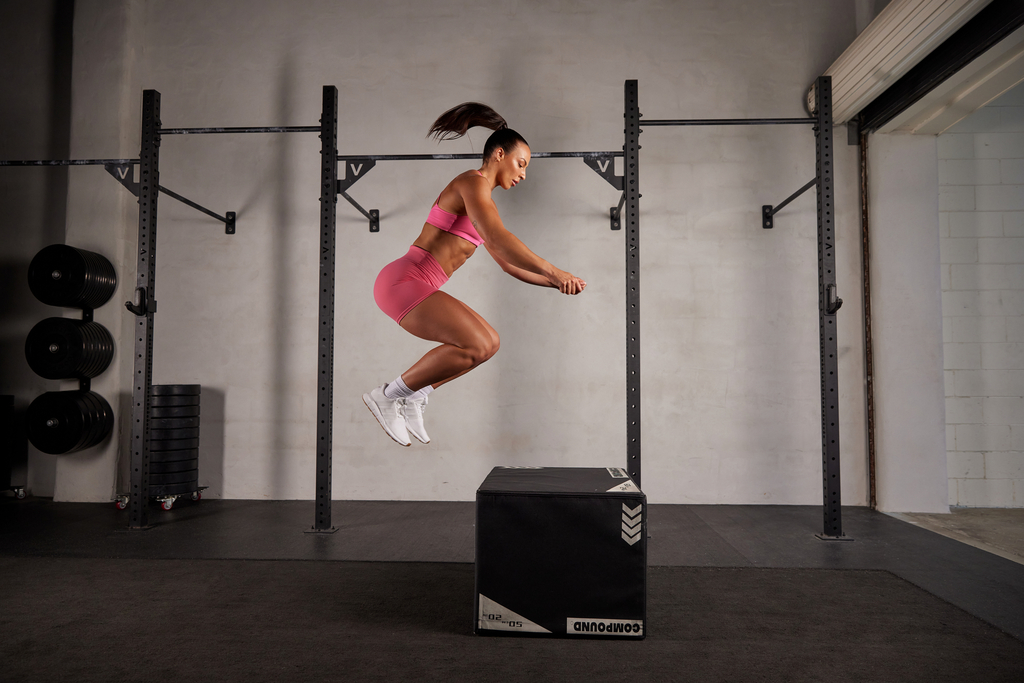If your experience with box jumps has involved bad landings, psyching yourself out at the last possible moment, or simply giving the box the side-eye and choosing another exercise instead, you’re not alone. Box jumps have a bit of a reputation as a downright intimidating movement, and it’s very common to have a bigger mental barrier to performing them than a physical one.
As long as your joints are happy with jumping movements and you want to get better at box jumps, this is an exercise that has the potential to skyrocket your fitness and explosive muscle power.
Here is everything you need to know about the benefits of box jumps, technique tips, common mistakes, plus alternative exercises and progressions. Soon enough, when we say jump, you’ll be saying how high?
What are the benefits of box jumps?
Box jumps fall into the plyometric training category, aka jumping exercises, and are an amazing way to build explosive muscle power, muscular endurance and cardiovascular fitness, as well as improving other components of your fitness such as balance, mobility, coordination, stability, agility and speed.
-
To build cardiovascular endurance, go for a higher number of reps and try to reduce your rest periods.
-
To build explosive muscular power, work on increasing the height of your box and lower your reps (or have more rest) if you need to.
-
To build lower body strength, focus on mastering your form. You want to be moving and landing with control while engaging the right muscles in every rep.
An added bonus? The cardio fitness, power, agility and speed involved in box jumps can support many other forms of training such as HIIT, running, lifting and team sports.
Which muscles do box jumps work?
Box jumps are primarily a lower-body exercise that targets your quads, calves, hamstrings and glutes as you bend into a squat position, jump high into the air and then land softly on the box in a squat before stepping down one foot at a time.
This movement primarily uses fast-twitch muscle fibres, which are responsible for explosive, powerful movements such as jumping, sprinting and power lifting.
Because they require balance, stability and control to make sure you land safely and with good form, box jumps also engage your core muscles, while swinging your arms for momentum can recruit some upper-body muscles.
How to do box jumps (correctly and safely)
Before we get into the nitty-gritty of this powerful exercise, let’s get one thing straight. You need to warm up properly first.
Performing plyometric exercises without a good warm-up can increase your risk of injuries such as sprains or muscle strains. There’s nothing explosive and powerful about being injured, so always prioritise your warm-up, even if it’s five minutes of cardio and some dynamic stretches. Every workout in the YogaFokus app comes with its own warm-up to help you take the guesswork out of this workout non-negotiable.
Secondly, it’s important to make sure you can perform a squat with proper form comfortably and confidently before you get started, as this is an essential part of a box jump.
Performing a box jump for the first time can be nerve-wracking, but our step-by-step breakdown with all the dos and don’ts can make it seem a little less daunting.
1. Choose your box
Do: opt for a box that’s around 12-16 inches. If that still feels too high, start with a low step to help build your confidence. Gyms often have cushioned boxes, which are a great beginner-friendly option, too. Should you fall onto the box or graze your shins – you’ll be landing on a soft surface rather than wood.
Don’t: start with a box that’s too high, as this can impact your form and increase your risk of injury. Don’t be afraid to start low!
2. Find your starting position
Do: stand about a foot away from your box with your feet hip-width apart and your arms by your sides.
Don’t: stand too close to the box or too far away. Standing super close to the box can feel safer, but a little bit of space allows you to bend your knees and jump without your feet or knees hitting the box. Unless you’re a pro (and ideally are using a cushioned box), too much distance between you and the box is a recipe for injury as it requires a much bigger leap. Starting with your feet together or wider than hip-width apart can also reduce your stability and jumping power.
3. Bend into jump position
Do: bend down into about a quarter or half squat position with your knees tracking over your toes, swinging your arms back behind you to prepare to swing upwards. If you’re new to this movement, feel free to skip the jump for a hot minute and just practice a half squat with arm swings.
Don’t: attempt a box jump if you’re not confident with bodyweight squat jumps yet. You also don’t need to be in a full-depth squat for a box jump.
4. Jump high, land soft
Do: swing your arms up into the air as you explosively jump off the floor with both feet at the same time, tucking your knees and feet up to land in a squat position with bent knees. You want your feet to land fully on the box at the same time – your heels shouldn’t be hanging off the edge. If you’re scared you won’t jump high enough to clear the box, it can help to position the box in front of a mirror and practice jumping into the air behind the box so you can see yourself confidently getting the height. Practicing step-ups on a box one foot at a time can also help build muscular strength and your confidence in using the box.
Don’t: jump or land with one foot at a time, land with your feet together, land with your heels hanging off the edge of the box, land with your knees bent in or bowed outwards, or land with straight legs.
5. Stand up straight
Do: extend your legs to stand up tall on the top of the box once you’ve completed your jump with a soft lading. This final movement ensures full extension of your hips and knees, maximising power and minimising the risk of injury.
Don’t: step or jump straight off the box from your bent-leg landing position. Always remember to stand up straight at the top.
6. Step down safely
Do: step backwards off the box onto the floor, one foot at a time, like you would on a ladder.
Don’t: jump off the box rather than stepping down one foot at a time – this can be hard on your joints and isn’t a safe dismount, especially if you’re in a busy gym environment.
Box jump alternatives
As fun and powerful as box jumps can be, they’re not for everyone. Some people don’t have access to a suitable box, others prefer to avoid high-impact exercises, or maybe you just can’t get past the fear of injury. All of these reasons are more than ok. Fitness should always be something that makes YOU feel good.
For a lower-body plyometric exercise that doesn’t require a box, squat jumps, tuck jumps, broad jumps and lunge jumps all make great options.
If you have access to a box but want a different option or a joint-friendly alternative, step-ups are fantastic. You can also add extra weight to make them more challenging, with dumbbells, a kettlebell, a medicine ball or a weight plate.
Work out anywhere, anytime with YogaFokus
Ready for your first workout?
Can’t get enough of box jumps or want to try them?
Heck yeah, you’ve got this! The following YogaFokus programs all feature box jumps:
-
Kayla Itsines’ High Intensity, High Intensity Strength, Energy Boost Challenge, and HIIT Cardio and Abs
-
Lift with Laura
-
FIERCE with Chontel Duncan
-
Cass Olholm’s High Intensity Strength and High Intensity Strength at Home

